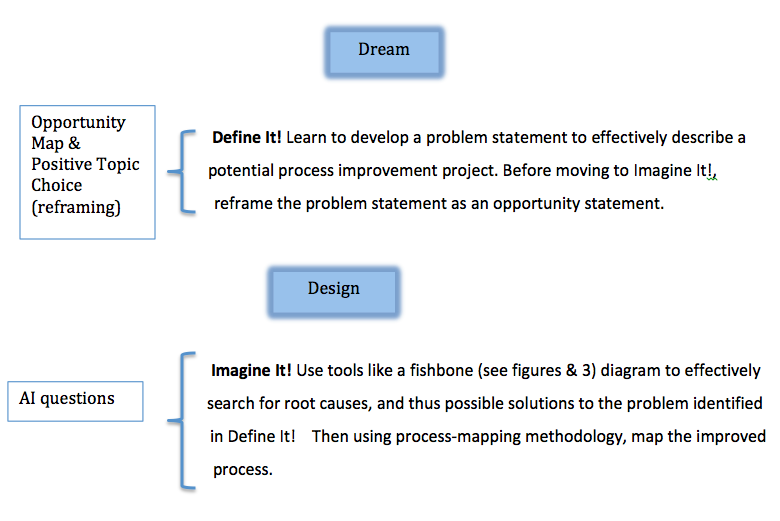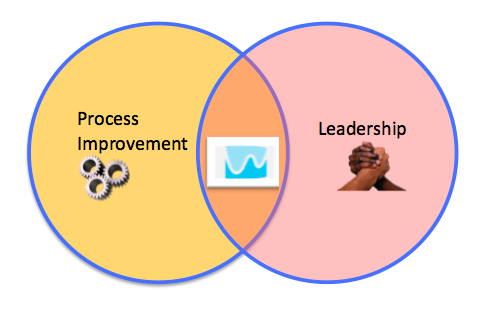This week, as I finish my certification process in Appreciative Inquiry (AI), I thought I’d give our readers a little understanding of how we’ve used AI and applied it to our process work.
Our process background has led us to focus on gap assessment and gap analysis as a primary methodology for seeking process improvements and identifying opportunities for improvement. Our facilitation methodology was usually centered around questions like: “What is your pain point?” Or “What is the one thing you would change?” Or “What would make things better?”
This type of gap assessment methodology is highly successful and works extremely well in organizations that:
- Have a strong (positive) organizational culture
- Are accustomed to process improvement or are seeking it out
- Have process aptitude or orientation
- Are resilient to change
We’ve applied the AI methodology to our Process Improvement Part One and Part Two courses (part of the Whiteboard University Curriculum that we’ll be offering this fall). Our Whiteboard Way teaches the following concepts:
- Define It! Learn to develop a problem statement to effectively describe a potential process improvement project.
- Draw It! Use basic process mapping tools to graphically represent the process at hand and begin to identify possible areas for bottlenecks, duplication of effort, or unclear roles and responsibilities.
- Imagine It! Use tools like a fishbone diagram to effectively search for root causes, and thus possible solutions to the problem identified in step 1.
- Prove It! Use data to demonstrate how the improved process could be measured against current performance.
- Talk About It! Effectively communicate process changes throughout the organization to support uptake of the new process and manage progress throughout.
We applied AI methodology (and Summit framework) in the following 2 steps of the Whiteboard Way:
 Tools We Use
Tools We Use
Opportunity Map
Following an exercise to identify problem statements from a number of groups, the problem statements are collected and documented on a whiteboard. Process improvement project problem statements are then reframed in the positive using AI methodology to talk about the ideal process or ideal experience to generate future state discussions that feature best-in-class processes.
Using multicoloured dots, individuals from each table group are able walk to the whiteboard and “vote with their feet” on the top 3-4 projects that are of most interest to each individual. The top 3-4 winning projects are then spaced around the room and participants are asked to join the project that is of most interest or that the participant feels could provide the most value from a knowledge perspective. For the most part teams naturally tend to be naturally evenly distributed, but wherever necessary shift to create somewhat equal participation between groups.
Using the opportunity map creates a great deal of engagement in the group. We have noticed that every person who joins a new project group has a vested interest in the outcome, and their excitement and engagement is palpable right away – versus teams being forced to work on pre-defined problem statements.
The re-shuffling of table groups based on working on the new problem statement of their choice truly helps to capture not only individual engagement, but the appropriate level of knowledge base within the group.
AI Questions/Reframing
In order to facilitate the Imagine It! portion, we first use traditional process improvement methodology using a fishbone diagram to determine possible root causes for the problem statement. This is where traditional process improvement would end – what we do differently is ask them to then consider the possible root causes, and using AI question techniques begin to envision a future state for the problem. The guided questions for each problem/opportunity statement are as follows:
- What is the current strength of this process?
- What are you proud of?
- Can you tell a story of when this process worked well?
- What are the key themes of success? (Using the Fishbone diagram as a guide: People, Processes, Materials, etc.)
- What does this process look like in one year, once it has been reengineered and is working effectively?
- What measures can we use to see how successful the new process is (versus the old process)?
- What things need to be done in order to get there?
The teams are then able to effectively leverage current components of the process that work the best, identify what needed to change, and what needs to happen in order to make that change.
Reflections on impact on participants
Using this new style of questioning is a fundamental change from classic process improvement. Often during the Imagine phase there is a great deal of change resistance to changing the process, especially when certain parts appear to be working. Leveraging the parts of the process that work well allows that resistance to diminish significantly. The “pain points” and “what is the one thing you would change” conversation in a typical gap assessment tend to devolve into “personnel issues” rather than process issues. Often people determine that it in fact was not the process that was broken, but the owner of those process steps that is to blame for the variability in the outcome of the process.
The AI methodology paired with gap analysis allows participants to steer clear of the negative, and focus on positive process improvements that are more fruitful than those that develop from pure process gap analysis alone (Click to Tweet).
Reflections on AI
While traditional gap assessment methodology is still a large component of process improvement initiatives, the use of AI is very effective when there is significant resistance to change or organizational culture issues that tend to draw negative conversations rather than opportunities. This is completely normal for process improvement where users of a process experience the effects of the change curve, namely first disbelief in the efficacy of the methodology, anger possibly due to fear of the unknown or lack of skills to execute the newly developed process,
New questions or observations
It would be interesting to document a process improvement project that used AI exclusively as a methodology against one that used gap analysis to assess whether the improvements using AI could in fact yield better results.
Our opinion is that differing methods work for different individuals, so blending the two approaches meets the needs of all stakeholders and will yield the best possible approach to engage a wide variety of thinking styles and communication styles.
Want to know more about AI and process improvement? Send us a note. Have any interesting AI stories? Join the conversation on Twitter @whiteboardcons.
Until next time,
Nicole





